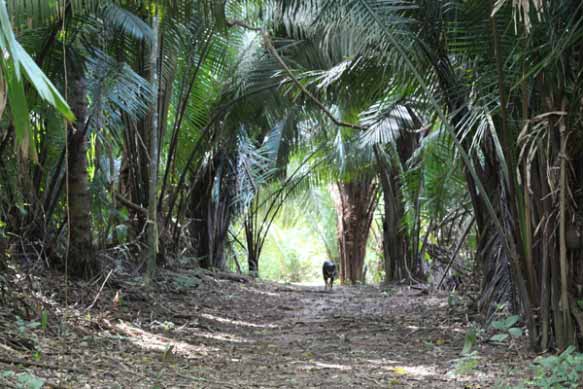
Multi-Purpose Maya Tree
Cohune Palm
ARECACEAE, Attalea cohune
One of the most prevalent trees found on Lower Dover Jungle Lodge’s 100 acre property is the Cohune Palm. Local Maya researchers observed that Cohunes are abundant where Maya ruins are found. Many believe the Maya had many practical uses for the tree (oil, roofing material, and even salt). Local guides go a step further and describe Maya shamans using the palms as prcaption
oof of their spirit connections. When the wind would blow through the palms located around their settlement, shamans would say…”I told you the Gods were listening!” Visit the Maya site at Lower Dover for proof of this phenomenon.

Maya Ruins at Lower Dover with Cohune Palms with dead leaves (left) and new growth (right).

Cohune Palms found at Maya site of Xunantunich (Right Front)
Another reason Cohune Palms are found in abundance is that the tree trunk is resistant to the common slash and burn agriculture practice used throughout Belize. On your trip to Belize, you will likely see many Cohune Palms still standing in farm pastures for that reason. When hiking the trails at Lower Dover Jungle Lodge, it is possible to see all the Cohune’s stages of growth, from seed bunches to well established trees. Along the Maya ruins of Lower Dover, the remains of past Cohune stumps are long gone, but perfectly round stump holes remain.

100's of Cohune Palms in all stages of growth can be seen at Lower Dover

Young Corozo Palms on medicinal plant trail at Lower Dover Belize Jungle Lodge
"Heart of Palm" or "Palmito" is a rare but well known local delicacy that is delicious in salads and commonly enjoyed over the Easter holiday. Unfortunately, to obtain the palm heart, the tree must be cut down, which is why they are so rare and usually carry a high cost.

Corozo Palm trunk growing mushrooms after palmito harvest
The nut is a favorite food of the gibnut, and is also eaten by people, despite the difficulty in cracking the shell. Cohune has a high oil content, yet it requires extensive extraction processing, so it's not very economically viable for biofuels. Many have tried to mechanize the process, but the Maya version of cracking the outer shell on stones, mashing the nuts by hand tool, and boiling the oil out in water remains the most effective way of extraction.

Cohune Palm Seed Cluster. Uniform in size and shape.

Cahoon Palm nuts scattered on the ground. Gibnuts love to eat them!
The British used the nut shell during World War I for charcoal filters in gas masks. Today, it's not as commonly used, as the nut can explode once the fire reaches the internal oily sections! The Brits used the Cohune nuts because the mature nut is uniform size, perfect for mass production.

Quash on Cohunn Palm Leaf at Lower Dover Belize Jungle Lodge
Today, the durable nut shells are polished & made into lovely brown jewelry. Rings, earrings, and bracelets are found throughout Belize made from the Cohune nuts. Purchase one of these lovely gifts for your friends from one of the many traditional Maya artisans outside of Xunantunich or in San Ignacio.
Lastly, much is being discovered about the actual benefits of palm oil. For the longest time consumers were misinformed about the many positives this oil provides. One such study is ongoing that shows the remarkable strides made in Alzheimer's Disease patients when they consume a regular intake of palm oil versus taking prescription drugs. Learn more about this fascinating discovery here.
SOURCE

